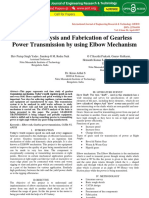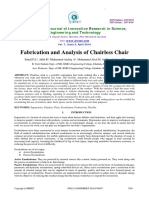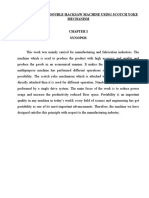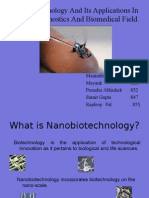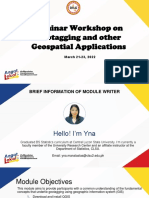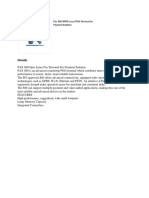Design and Fabrication of Paper Cutting Machine Using Geneva Mechanism
Design and Fabrication of Paper Cutting Machine Using Geneva Mechanism
Uploaded by
Kunal BidkarCopyright:
Available Formats
Design and Fabrication of Paper Cutting Machine Using Geneva Mechanism
Design and Fabrication of Paper Cutting Machine Using Geneva Mechanism
Uploaded by
Kunal BidkarOriginal Title
Copyright
Available Formats
Share this document
Did you find this document useful?
Is this content inappropriate?
Copyright:
Available Formats
Design and Fabrication of Paper Cutting Machine Using Geneva Mechanism
Design and Fabrication of Paper Cutting Machine Using Geneva Mechanism
Uploaded by
Kunal BidkarCopyright:
Available Formats
ISSN (Online): 2319-8753
ISSN (Print) : 2347-6710
International Journal of Innovative Research in Science,
Engineering and Technology
(A High Impact Factor, Monthly, Peer Reviewed Journal)
Visit: www.ijirset.com
Vol. 8, Issue 4, April 2019
Design and Fabrication of Paper Cutting
Machine using Geneva Mechanism
Sagar R. Patil 1, Fenil Y. Manani1 , Nikhil R. Mhatre 1, Abhishek P. Poojary 1, S. M. Gaikwad 2
U.G. Student, Department of Mechanical Engineering, Mahatma Gandhi Mission’s College of Engineering and
Technology, Kamothe, Navi Mumbai, India1
Professor, Department of Mechanical Engineering, Mahatma Gandhi Mission’s College of Engineering and
Technology, Kamothe, Navi Mumbai,, India2
ABSTRACT: The main principle of the project is to reduce the human fatigue and time consumption by eliminating
the marking time required to cut paper in equal lengths. Our proposed system cuts variable size paper in equal and
accurate dimensions based on Geneva mechanism. Geneva mechanism converts continuous rotary motion into
intermittent rotary motion. We use a shaft which is in association with the rotating handle. This shaft has a connecting
rod (string) which is connected to a scissor in order to drive the cutting mechanism for cutting paper. This shaft is
connected to a sprocket which is in turn connected by a chain to another sprocket. This sprocket is now connected to a
Geneva wheel. This wheel is used to drive paper feed into the cutter mechanism. The paper cutting is achieved by crank
and rocker mechanism. The cutter will be restored back to its original position by a restoring spring. Here we use
Geneva mechanism driven by another connecting rod. This mechanism ensures paper feed of equal length inserted at
proper time intervals. System uses a supporting frame that maintains proper coordination between feed and cutting
mechanism. It proves to be low cost solution in production and can be used in educational institutes, stationary shops,
small scale industries.
KEYWORDS: crank and rocker mechanism, Geneva mechanism, sprocket, paper roller
I. INTRODUCTION
The task of a mechanical engineer is to synthesize and implement a particular mechanism so as to get a particular
output and to remodel or to develop combination of two or more different mechanisms to get the same output. The
mechanisms which we have used in our project are Geneva mechanism and crank and rocker mechanism that we learnt
in Theory of Machine-1.
GENEVA MECHANISM
Fig.1 Geneva mechanism
Copyright to IJIRSET DOI:10.15680/IJIRSET.2019.0804010 3705
ISSN (Online): 2319-8753
ISSN (Print) : 2347-6710
International Journal of Innovative Research in Science,
Engineering and Technology
(A High Impact Factor, Monthly, Peer Reviewed Journal)
Visit: www.ijirset.com
Vol. 8, Issue 4, April 2019
Geneva mechanism (Fig.1) is a mechanism that translates a continuous rotation into an intermittent rotary motion,
using an intermittent gear where the drive wheel has a pin that reaches into a slot of the driven wheel and thereby
advances it by one step, and having a raised circular blocking disc that locks the driven wheel in position between steps.
The Geneva wheel is a cam like mechanism that provides intermittent rotary motion and is widely used in both low and
high-speed machinery. The name derives from the device’s earlier application in mechanical watchesas a stop to
prevent over winding of watches, it is now extensively used in automatic machinery. Geneva drive is also called as
Maltese cross due to its visual resemblance when the driven wheel has four slots.
There are 3 types of Geneva drive: -
1. External Geneva mechanism
Fig.2External Geneva mechanism
In this type of mechanism (Fig.2), the Geneva cross is connected with cam driveexternally which is the most popular
and can withstand higher mechanicalstresses. The driver grooves lock the driven wheel pins during dwell. During
movement, the driver pin mates with the driven-wheel slot.
2. Internal Geneva mechanism
Fig.3 Internal Geneva mechanism
In this type of mechanism, the Geneva cross and cam drive are connectedinternally in the closed box. The driver and
driven wheel rotate in samedirection. The duration of dwell is more than 180º of driver rotation.
Copyright to IJIRSET DOI:10.15680/IJIRSET.2019.0804010 3706
ISSN (Online): 2319-8753
ISSN (Print) : 2347-6710
International Journal of Innovative Research in Science,
Engineering and Technology
(A High Impact Factor, Monthly, Peer Reviewed Journal)
Visit: www.ijirset.com
Vol. 8, Issue 4, April 2019
3. Spherical Geneva mechanism
Fig.4 Spherical Geneva mechanism
In this type of mechanism(Fig.4), the Geneva cross is in spherical shape and camdrive are connected in externally,
which is extremely rare. The driver anddriven wheel are on perpendicular shafts. The duration of dwell is exactly180°
of driver rotation.
From the above mentioned 3 types the external type Geneva mechanism is used in our project since it can withstand
high mechanical stresses.
CRANK AN ROCKER MECHANISM
Fig.5 crank and rocker mechanism
In this mechanism (Fig.5), for one complete rotation of the crank the rocker oscillates which help in the cutting action
of the paper.
II. LITERATURE SURVEY
Vijay Kumar U, Ghanshyam Kumar and Dharesh Bansod [1], studied that their machine overcomes the demerit by
compact size, less cost no need for skilled people and there is no need of electrical input. The main aim of their
machine is to reduce timing for paper cutting and neglect the time for marking the paper. This aim can be achieved by
this machine.
Copyright to IJIRSET DOI:10.15680/IJIRSET.2019.0804010 3707
ISSN (Online): 2319-8753
ISSN (Print) : 2347-6710
International Journal of Innovative Research in Science,
Engineering and Technology
(A High Impact Factor, Monthly, Peer Reviewed Journal)
Visit: www.ijirset.com
Vol. 8, Issue 4, April 2019
Ajay S. Parmar, Amar Singh and Avinash Singh [2], concluded that the feed, which came from the Geneva mechanism
carried by the chain drive, is cut by the crank lever mechanism, which is at the end of the chain drive. By using this
model, they can get the same length of feed at same interval of time. The length of the feed can be managed by
changing the depth of the slots in Geneva wheel and the path length of the crank can be increased by increasing the
radius of the crank and the length of the lever cutter and by changing the number of slots on Geneva wheel.
S R Durai and Arun kumar [3], concluded that their machine is very useful for small and medium scale industries. This
machine is used to cut the paper and small thickness of sheet. Therefore, there may be the chances of increase in
production rate by simultaneously cutting the number of sheets in a single pass. Reduction of man power. Reduction in
cost as compare to conventional machines. Is the major advantage of this project.
Rakesh Prajapati, Purvik Patel and Saurabh Modi [4], concluded that the paper feed is adjusted by changing the
circumference of the roller. Thus the paper cutting in accurate dimensions without marking the paper is achieved by
getting the intermittent motion by Geneva mechanism. This intermittent motion is used to feed the paper between the
cutting periods of the crank and lever mechanism.
Kalisindhur et al. [5], designed a mechanism for cutting by giving intermittent feed. This intermittent feed is given by
continuous rotation of circular disc in Geneva mechanism. He designed a belt drive with the help of Geneva
mechanism which is used for giving feed and gives smooth operation and smooth movement of the feed at required
time interval. The feed from the Geneva drive was cut by using slotted lever mechanism which was designed using
slider crank mechanism.
III. EXPERIMENTAL SETUP
Fig. 6 side view of the machine
Copyright to IJIRSET DOI:10.15680/IJIRSET.2019.0804010 3708
ISSN (Online): 2319-8753
ISSN (Print) : 2347-6710
International Journal of Innovative Research in Science,
Engineering and Technology
(A High Impact Factor, Monthly, Peer Reviewed Journal)
Visit: www.ijirset.com
Vol. 8, Issue 4, April 2019
Fig. 7 top view of the machine
Overall size of the machine L 36˝ x W 24˝ x H 12˝
Components used in the machine setup and specifications: -
Sr no. Name of component Quantity
1. Front wooden support H12˝x W4.5˝ 2
2. Back wooden support H7˝x W4.5˝ 2
3. Front handle 9.5˝x 0.5˝ 1
4. Scissor handle 7˝x 0.75˝ 1
5. Scissor 52.6cm x 18.6cm x 6.5cm, 1kg 1
6. Geneva 5˝ x 1˝ 1
7. Bearing 6200 6
ID 11mm OD 33mm
8. Roller chain 1
9. Shaft 1
10. L clamp 1˝ x 1˝ 6
L clamp 1.5˝ x 1.5˝ 6
11. Pinch roller 2
12. Screw 4 dozen
Self-tapping screw BIG M 4x13mm 1 dozen
Self-tapping screw MEDIUM M 4x9.5mm 1dozen
Self-tapping screw SMALL M 4x6.5mm 1 dozen
13. Nut bolt 6˝ 2
14. Wiser 6˝ 2 dozen
15. Spring 2
Copyright to IJIRSET DOI:10.15680/IJIRSET.2019.0804010 3709
ISSN (Online): 2319-8753
ISSN (Print) : 2347-6710
International Journal of Innovative Research in Science,
Engineering and Technology
(A High Impact Factor, Monthly, Peer Reviewed Journal)
Visit: www.ijirset.com
Vol. 8, Issue 4, April 2019
IV. WORKING
In the most common arrangement, the driven wheel has four slots and thus advances by one step of 90˚ for each
rotation of the drive pin. The machine proposed by us also has four slots on Geneva wheel but it advances by 180˚ for
each rotation of the drive pin. That is the basic machine uses 90˚ of rotation of Geneva wheel for feed and rest 270˚
(dwell) for cutting operation whereas our machine uses 180˚ for feeding and rest 180˚(dwell) for cutting.
Our machine primarily focuses on cutting of A4 size paper (29.7 x 21 cm) in equal intervals of time and with good
accuracy.
The following steps can be seen as the handle is rotated in clockwise direction: -
1. When the driver pin is in top position i.e. engage position, the crank will be at the bottom position. here the
scissor is in full open position and the paper is fed into the cutter.
2. When the driver pin is in bottom position i.e. disengage position, the crank will be at the top position here the
scissor is in full cutting position and accordingly the paper is cut.
In this way the A4 size paper cutting is obtained by the above mentioned steps.
V. RESULT
The size of the paper which we obtained after the experiment is similar to that of the A4 size paper when compared
with standard size of A4 paper. The feed which we get from the roller which is driven by Geneva mechanism is 29.7cm
(which is length of the A4 size paper) and hence the scissor is able to cut A4 size paper.
VI. CONCLUSION
By using the above proposed machine, we can get the same length of feed and cutting in equal intervals of time. The
aim of this machine is to reduce the timing for paper cutting and neglect the time for marking the paper. Further,
variable sizes of paper can be obtained as per the need of the user just by changing the setting of the machine i.e. either
by,
1. Changing the no. of slots on Geneva wheel
2. Changing the depth of slots on Geneva wheel
3. Increasing or decreasing the radius of the driver pin
4. Changing the length of the cutter
5. Changing the radius of paper roll
There are other paper cutting machines which have demerits like bulky in nature, costly, need skilled labour to operate
and mainly it needs electrical input. But our machine overcomes the demerits of those machines up to a greater extent
that is it does not require skilled labour to operate, cost effective, not bulky in nature and mainly it does not require any
electrical input or power supply.
As we know that the the basic machine uses 90˚ of rotation of Geneva wheel for feed and rest 270˚ (dwell) for cutting
operation whereas our machine uses 180˚ for feeding and rest 180˚(dwell) for cutting. So it can be seen that dwell angle
for Geneva wheel is reduced by 90˚ and the feed angle for Geneva wheel is increased by 90˚ which assures reduction in
time for paper cutting and increasing the length of feed of the paper.
Copyright to IJIRSET DOI:10.15680/IJIRSET.2019.0804010 3710
ISSN (Online): 2319-8753
ISSN (Print) : 2347-6710
International Journal of Innovative Research in Science,
Engineering and Technology
(A High Impact Factor, Monthly, Peer Reviewed Journal)
Visit: www.ijirset.com
Vol. 8, Issue 4, April 2019
REFERENCES
[1] Vijay Kumar U, Ghanshyam Kumar, Dharesh Bansod, Deepak Sahu, Rishabh Bendre and Aakanksha Suryawanshi, “Design and Analysis of
Paper Cutting Machine work on the Geneva Mechanism”, IJARIIE,2(2), 2016, 35-43.
[2] Ajay S. Parmar, Amar Singh, Avinash Singh, Avneesh Pandey, Kunal Singh, Maneesh Upadhyay, “Intermittent Paper Cutting Mechanism by
Giving Feed through Geneva Wheel”, IRJET vol:04 Issue 05, may 2017.
[3] Rakesh Prajapati, Purvik Patel, Saurabh Modi, “Design and Development of Machine to Perform Stamping and Cutting”, IJAERD, special issue
SIEICON-2017, April 2017.
[4] Sunil H V, Ankit Yadav, Shivu L, Santosh Choudri, “Automatic Paper Cutting Machine using Geneva Mechanism”, IJLERA, vol:2, issue -05,
May-2017.
[5] G. Arundeesh, R. Rathish, Logeshwaran, N. Maniraj, V. Mohan Raju Kamatchi, V. Poovarasan, “Design and fabrication of paper cutting”,
IJRAME, vol:5 issue 4, April 2017 pg. 7-11
[6] P.Kalisindhur, Y.Karthik, T.Vijay, Y.Sasikanth and G. Sri Harsha, “cutting mechanism by giving feed through Geneva Mechanism”, IJISET,2(4),
2015, 1172-1175.
Copyright to IJIRSET DOI:10.15680/IJIRSET.2019.0804010 3711
You might also like
- 6.2 Why The Future Does Not Need UsDocument15 pages6.2 Why The Future Does Not Need UsCarolyn Elizabeth Barcemo93% (15)
- Design and Fabrication of The Rotating & Tilting Vice: I J I R S E TDocument3 pagesDesign and Fabrication of The Rotating & Tilting Vice: I J I R S E TSureshNo ratings yet
- 68 - Design - Analysis - Fabrication of Maglev Vertical Axis Wind Turbine-VAMWTDocument12 pages68 - Design - Analysis - Fabrication of Maglev Vertical Axis Wind Turbine-VAMWTriya vermaNo ratings yet
- 350 - Design and Fabrication of Foot Pedal Operated Corn Deseeding MachineDocument9 pages350 - Design and Fabrication of Foot Pedal Operated Corn Deseeding MachineSarfaraz anwarNo ratings yet
- 87 DesignDocument4 pages87 Designmadhanreddy953No ratings yet
- 18 Proposed NutDocument8 pages18 Proposed NutKbrom MekonenNo ratings yet
- Design and Development of Peanut Peeler MachineDocument7 pagesDesign and Development of Peanut Peeler MachineKristoffer SamsonNo ratings yet
- Design & Development of Twin Drill Head Machine and Drilling Depth ControlDocument12 pagesDesign & Development of Twin Drill Head Machine and Drilling Depth ControlSolomon DuferaNo ratings yet
- 13 013 Design PDFDocument6 pages13 013 Design PDFMayur RaundalNo ratings yet
- Design and Fabrication of Angular DrillingDocument8 pagesDesign and Fabrication of Angular DrillingvasanthNo ratings yet
- Minor Project PPT FormatDocument11 pagesMinor Project PPT FormatEnd JainsbondNo ratings yet
- Gearless Transmission Mechanism and Its ApplicationsDocument6 pagesGearless Transmission Mechanism and Its ApplicationsChandrasekhar KolluNo ratings yet
- 268 Gearless MergedDocument53 pages268 Gearless Mergedonkargawade07No ratings yet
- Mechanically Operated Cart For Pesticide Sprayer For AgricultureDocument8 pagesMechanically Operated Cart For Pesticide Sprayer For AgricultureabiNo ratings yet
- Analysis and Optimization of Centrifugal: Blower Using CFDDocument6 pagesAnalysis and Optimization of Centrifugal: Blower Using CFDShridhar RaskarNo ratings yet
- Vibration Analysis of Single Point Cutting Tool On Lathe Machine by Using FFT AnalyzerDocument8 pagesVibration Analysis of Single Point Cutting Tool On Lathe Machine by Using FFT AnalyzerMukesh ChoudhuryNo ratings yet
- Design, Development and Automation of Hydraulic Broaching MachineDocument8 pagesDesign, Development and Automation of Hydraulic Broaching MachineMuftah AhmedNo ratings yet
- PD ReportDocument6 pagesPD Reportbitish commectNo ratings yet
- Fabrication of Multicrop Cutter PDFDocument6 pagesFabrication of Multicrop Cutter PDFJanus VishalNo ratings yet
- Development of Modified System For Round Ring Cloth Peg AssemblyDocument3 pagesDevelopment of Modified System For Round Ring Cloth Peg AssemblyEditor IJTSRDNo ratings yet
- 43 Rtmeas67Document20 pages43 Rtmeas67c.farhan.fNo ratings yet
- Design and Fabrication of Multi Process Machine Using Scotsh Yoke Mechanism IJERTCONV7IS06031Document2 pagesDesign and Fabrication of Multi Process Machine Using Scotsh Yoke Mechanism IJERTCONV7IS06031Sushant GhurupNo ratings yet
- Design, Analysis and Testing of Spindle For High Speed CNC Lathe MachineDocument8 pagesDesign, Analysis and Testing of Spindle For High Speed CNC Lathe MachineArif NurrohmanNo ratings yet
- A Review On Study and Analysis of Geneva Mechanism Design: S.R.Durai Raju, Arun Kumar.C, Karan Kumar.R, Thiyagarajan.ADocument9 pagesA Review On Study and Analysis of Geneva Mechanism Design: S.R.Durai Raju, Arun Kumar.C, Karan Kumar.R, Thiyagarajan.AImee Kassandra Estomo CachoNo ratings yet
- Modification of The Geneva Paper Cutting Tool: January 2019Document6 pagesModification of The Geneva Paper Cutting Tool: January 2019Abhishek KumarNo ratings yet
- Sckotch Yoke MechanismDocument5 pagesSckotch Yoke MechanismShubham Magdum100% (1)
- Automated Manual Transmission Using Servo Motors For Sequential GearboxDocument6 pagesAutomated Manual Transmission Using Servo Motors For Sequential GearboxGhafar HassanNo ratings yet
- Conceptual Design and Development of Shredding Machine For Agricultural WasteDocument7 pagesConceptual Design and Development of Shredding Machine For Agricultural WasteVJ CarbonellNo ratings yet
- Design and Development of Pneumatically Operated Automatic Seed Sowing MachineDocument8 pagesDesign and Development of Pneumatically Operated Automatic Seed Sowing MachineSathiyaNo ratings yet
- 3-Axis CNC Router Modifiable To 3D Printer: Nternational Ournal of Nnovative Esearch in Cience, Ngineering and EchnologyDocument8 pages3-Axis CNC Router Modifiable To 3D Printer: Nternational Ournal of Nnovative Esearch in Cience, Ngineering and EchnologyAmer AlbasserNo ratings yet
- Design Analysis and Fabrication of Gearless PowerDocument4 pagesDesign Analysis and Fabrication of Gearless PowerShreenivas PanchalNo ratings yet
- Design Analysis and Fabrication of MagleDocument12 pagesDesign Analysis and Fabrication of MagleAayush AryaNo ratings yet
- Downloads Papers N59304de064e92Document16 pagesDownloads Papers N59304de064e92MakeshNo ratings yet
- Trends in MachinetoolsDocument8 pagesTrends in Machinetoolsmohan SRNo ratings yet
- IJCRT1813325Document5 pagesIJCRT1813325sachinNo ratings yet
- Drilling, Cutting and Grinding System MechanismDocument6 pagesDrilling, Cutting and Grinding System MechanismPrince PathakNo ratings yet
- Defect Identification in CNC Manufactured Products and Their Control MeasureDocument7 pagesDefect Identification in CNC Manufactured Products and Their Control MeasureSridharan VenkatNo ratings yet
- Design and Development of A Low-Cost Exure-Based Hand-Held Mechanism For MicromanipulationDocument7 pagesDesign and Development of A Low-Cost Exure-Based Hand-Held Mechanism For MicromanipulationDamián Cortina LópezNo ratings yet
- Me - 051Document9 pagesMe - 051John CenaNo ratings yet
- Development and Fabrication of Multi-Purpose Machine: Praveen Karanam, Karthik A.V., Akshay S Bhat, Swaroop H.P., GaneshDocument6 pagesDevelopment and Fabrication of Multi-Purpose Machine: Praveen Karanam, Karthik A.V., Akshay S Bhat, Swaroop H.P., GaneshBADINEHALSANDEEPNo ratings yet
- 57 - Fabrication and Analysis of Chairless Chair 1 - 1Document9 pages57 - Fabrication and Analysis of Chairless Chair 1 - 1Akash Chiman100% (1)
- Modification of The Geneva Paper Cutting Tool: Sakshi, Nupoor Jain, Mrs. Anjul RaiDocument5 pagesModification of The Geneva Paper Cutting Tool: Sakshi, Nupoor Jain, Mrs. Anjul RaiZia Ur RehmanNo ratings yet
- Design and Fabrication of Padal Operated Sieving Machine For Agriculture Use Ijariie16697Document8 pagesDesign and Fabrication of Padal Operated Sieving Machine For Agriculture Use Ijariie16697Hussen KedirNo ratings yet
- 37 Design NDocument8 pages37 Design NEmmanuel MatutuNo ratings yet
- 101.VISHNU-PRAGASH.Document6 pages101.VISHNU-PRAGASH.Ramakarunananda MadalliNo ratings yet
- Blade ArrangmentsDocument6 pagesBlade ArrangmentsRavi MirzaNo ratings yet
- Multi-Function Operating Machine A Conceptual ModeDocument8 pagesMulti-Function Operating Machine A Conceptual ModemadhuorgantiNo ratings yet
- Design of Magnetic Levitation TrainDocument6 pagesDesign of Magnetic Levitation TrainDwi Agung PratamaNo ratings yet
- Design and Fabrication of Multipurpose Eco-Friendly Cleaning MachineDocument5 pagesDesign and Fabrication of Multipurpose Eco-Friendly Cleaning MachineIJRASETPublications0% (1)
- dOUBLE HACKSAWDocument29 pagesdOUBLE HACKSAWKalai SelvanNo ratings yet
- ReportDocument4 pagesReportTanjid Al TajimNo ratings yet
- Design and Fabrication of Floor Cleaning Machine - A ReviewDocument4 pagesDesign and Fabrication of Floor Cleaning Machine - A ReviewIJIERT-International Journal of Innovations in Engineering Research and Technology100% (1)
- Fabrication of Automatic Drilling & Tapping MachineDocument5 pagesFabrication of Automatic Drilling & Tapping MachineIJRASETPublicationsNo ratings yet
- Multi-Function Operating Machine: A Conceptual Model: Sharad Srivastava, Shivam Srivastava, C.B.KhatriDocument10 pagesMulti-Function Operating Machine: A Conceptual Model: Sharad Srivastava, Shivam Srivastava, C.B.KhatriAnkit SinghNo ratings yet
- Design and Fabrication of Multi-Purpose Sieving MachineDocument6 pagesDesign and Fabrication of Multi-Purpose Sieving MachineMICHEL RAJ MechNo ratings yet
- Design and Fabrication of Automatic Paper Cutting MachineDocument4 pagesDesign and Fabrication of Automatic Paper Cutting MachineVivace SystmNo ratings yet
- Group 1Document6 pagesGroup 1Devendra Pratap SinghNo ratings yet
- Micrometers - Slide Gauges and Calipers - Principles, Construction, Operation and Use of Appliances for Fine Mechanical MeasurementsFrom EverandMicrometers - Slide Gauges and Calipers - Principles, Construction, Operation and Use of Appliances for Fine Mechanical MeasurementsNo ratings yet
- Process Control for Sheet-Metal Stamping: Process Modeling, Controller Design and Shop-Floor ImplementationFrom EverandProcess Control for Sheet-Metal Stamping: Process Modeling, Controller Design and Shop-Floor ImplementationNo ratings yet
- Modelling of Vibrations of Overhead Line Conductors: Assessment of the TechnologyFrom EverandModelling of Vibrations of Overhead Line Conductors: Assessment of the TechnologyGiorgio DianaNo ratings yet
- Advanced Noncontact Cutting and Joining Technologies: Micro- and Nano-manufacturingFrom EverandAdvanced Noncontact Cutting and Joining Technologies: Micro- and Nano-manufacturingNo ratings yet
- Zuwena Presentation For WaterAid India Workshop March 2016 - CGHEWebDocument32 pagesZuwena Presentation For WaterAid India Workshop March 2016 - CGHEWebBonita SugehaNo ratings yet
- Portrait of An ENTP - : The VisionaryDocument3 pagesPortrait of An ENTP - : The VisionaryMalaka BatuwanthudawaNo ratings yet
- PP in Automotive Applications PDFDocument16 pagesPP in Automotive Applications PDFphaniraj_cNo ratings yet
- Theoretical Framework and ParadigmDocument4 pagesTheoretical Framework and Paradigmangelu abionNo ratings yet
- Eractive Multimedia Making Information Fun and EngagingDocument12 pagesEractive Multimedia Making Information Fun and EngagingFiona MorigoNo ratings yet
- Chapter 13Document8 pagesChapter 13allyssa orobiaNo ratings yet
- Tutorial 4Document17 pagesTutorial 4Mariz Ellaine BaltazarNo ratings yet
- DEFENCEDocument50 pagesDEFENCEsathsihNo ratings yet
- Altivar Easy 310 - ATV310HU40N4EDocument7 pagesAltivar Easy 310 - ATV310HU40N4ETùng ĐặngNo ratings yet
- Lubrizol 2063: Product DescriptionDocument2 pagesLubrizol 2063: Product DescriptionMOHAMED GamalNo ratings yet
- Nanobiotechnology and Its Applications in Medical Diagnostics and Biomedical Field 1Document49 pagesNanobiotechnology and Its Applications in Medical Diagnostics and Biomedical Field 1Pranshu AbhishekNo ratings yet
- Readymix ProfileDocument33 pagesReadymix ProfileAyman HammodehNo ratings yet
- IIBM Institute of Business Management PDFDocument12 pagesIIBM Institute of Business Management PDFNarendra Chaurasia100% (1)
- Z Bus Computation For Networks Having Mutually Coupled Elements Using Uncoupled Equivalents of Coupled GroupsDocument4 pagesZ Bus Computation For Networks Having Mutually Coupled Elements Using Uncoupled Equivalents of Coupled GroupsKanav MahajanNo ratings yet
- Analog and Digital ElectronicsDocument111 pagesAnalog and Digital ElectronicsShiva CharanNo ratings yet
- CA 2 MCQ Set1Document2 pagesCA 2 MCQ Set1Amulya RajNo ratings yet
- 2022 March LM No 2 Getting Familiar With QGIS (DILG Template)Document111 pages2022 March LM No 2 Getting Familiar With QGIS (DILG Template)Jahara CanutoNo ratings yet
- L150/C/D/E/F: Ground Engaging Tools / Wheel Loaders / Volvo Tooth SystemDocument2 pagesL150/C/D/E/F: Ground Engaging Tools / Wheel Loaders / Volvo Tooth SystemLucky OkoteNo ratings yet
- MAIN Electrical Parts List: (SM-A750FN)Document44 pagesMAIN Electrical Parts List: (SM-A750FN)Angie Luna CNo ratings yet
- Ipcr 2023-2024 - 014401Document9 pagesIpcr 2023-2024 - 014401jaynalsofyanNo ratings yet
- Qulik Modern Crystal Chandelier Hanging LED Ceiling Light (QL-3316-500 - Alphaeshop LimitedDocument1 pageQulik Modern Crystal Chandelier Hanging LED Ceiling Light (QL-3316-500 - Alphaeshop LimitedSajol Al AminNo ratings yet
- Original Operating Manual 150 000 044 00 US: Round BalerDocument142 pagesOriginal Operating Manual 150 000 044 00 US: Round BalerPawełOsadaNo ratings yet
- Lab 2 Analog Input and Output: ComponentsDocument5 pagesLab 2 Analog Input and Output: ComponentsAbdul AzizNo ratings yet
- GSP LettersDocument11 pagesGSP LettersRHYSLYN RUFIN SALINASNo ratings yet
- Instruction Manual: FVR-E11S-7EN FVR-E11S-4ENDocument116 pagesInstruction Manual: FVR-E11S-7EN FVR-E11S-4ENminh đạo nguyễnNo ratings yet
- Monica Hernandez Resume FinalDocument2 pagesMonica Hernandez Resume Finalapi-281124419No ratings yet
- Avinash 2Document3 pagesAvinash 2avinashunix830No ratings yet
- Slide Trí Tuệ Nhân Tạo - Lecture04 - CSP - Phạm Bảo Sơn - UETDocument40 pagesSlide Trí Tuệ Nhân Tạo - Lecture04 - CSP - Phạm Bảo Sơn - UETNgocNo ratings yet
- Details Linux Based Pax S80 ARM ProcesorDocument2 pagesDetails Linux Based Pax S80 ARM Procesorkakyo29433No ratings yet






























